The Mangrove Cuckoo (Coccyzus minor) emerges as a captivating avian inhabitant of coastal mangrove ecosystems in the Americas, weaving a narrative of adaptability and mystery within its unique habitat.
Characterized by its medium size, intricate facial markings, and elusive behavior, the Mangrove Cuckoo thrives in the tangled foliage of mangrove forests, offering a harmonious blend of camouflage and survival skills.
With a range spanning from the southern United States to northern South America, these birds exhibit a distinct preference for coastal habitats, relying on the bounty of insects and invertebrates found within the mangrove ecosystem.
Despite their discreet nesting habits and subtle plumage, the Mangrove Cuckoo leaves an indelible mark on the avian landscape, illustrating the delicate interplay between adaptation and ecological niche in its coastal realm.
Understanding the intricacies of the Mangrove Cuckoo enriches our appreciation for the complexities of avian life within the dynamic tapestry of mangrove ecosystems. Stay focused.
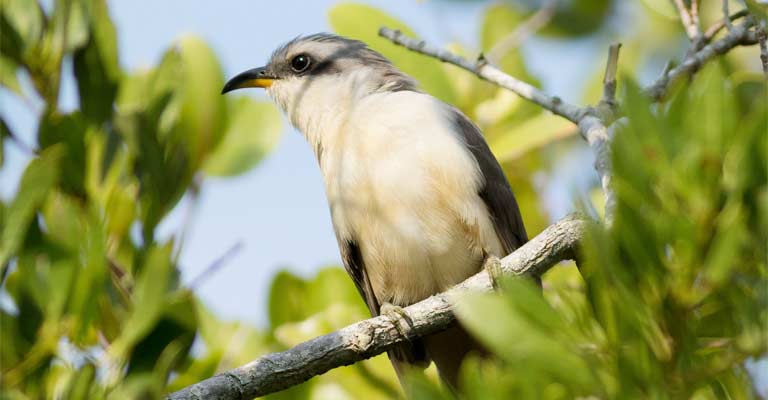
Taxonomy of Mangrove Cuckoo
The table below will tell you everything about the taxonomy details of the Mangrove Cuckoo:
| Taxonomic Rank | Classification |
| Domain | Eukaryota |
| Kingdom | Animalia |
| Phylum | Chordata |
| Class | Aves |
| Order | Cuculiformes |
| Family | Cuculidae |
| Genus | Coccyzus |
| Species | C. minor |
The Mangrove Cuckoo (Coccyzus minor) belongs to the family Cuculidae, which encompasses a diverse group of medium to large-sized cuckoos.
Within the Coccyzus genus, several closely related species share the same taxonomic classification.
These include the Yellow-billed Cuckoo (Coccyzus americanus), the Black-billed Cuckoo (Coccyzus erythropthalmus), and the Hispaniolan Lizard-Cuckoo (Coccyzus longirostris).
All these species share common traits, such as a slender build, long tails, and distinctive facial markings.
Their taxonomy reflects their evolutionary relationships within the broader cuckoo family, providing insights into the diverse adaptations that have evolved within this avian lineage.
Individualizing Criteria of Mangrove Cuckoo
The Mangrove Cuckoo (Coccyzus minor) is a distinctive bird species inhabiting coastal mangrove ecosystems in the Americas.
Identifying this specific bird requires attention to various characteristics, and here are some key points to aid in the individualization of the Mangrove Cuckoo.
Size and Shape
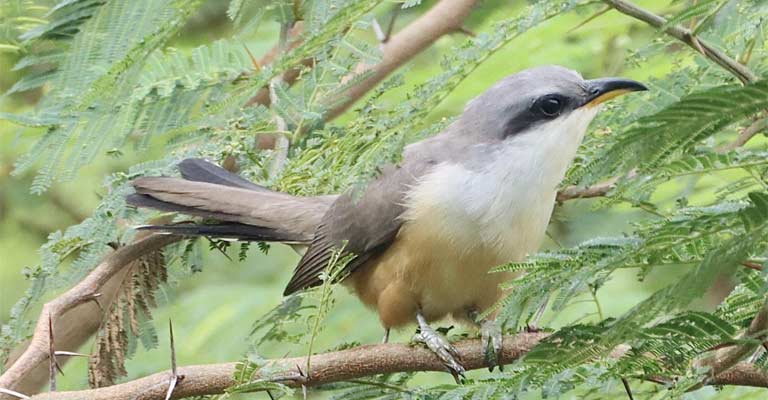
The Mangrove Cuckoo is a medium-sized bird with a length ranging from 11 to 12 inches. It has a slender and elongated body, with a long tail that often extends beyond its body.
Its overall shape, featuring a slightly curved bill and a distinctive cuckoo-like appearance, helps distinguish it from other bird species in its habitat.
Coloration
The plumage of the Mangrove Cuckoo is predominantly brown on the upperparts, while the underparts are paler with a buffy or cinnamon tint.
The tail has broad white tips, creating a contrasting pattern. The overall coloration aids in camouflaging the bird within the dense foliage of mangrove forests.
Facial Markings
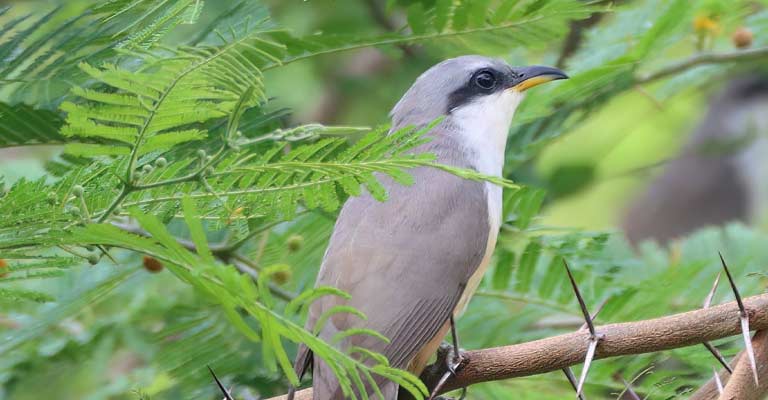
Pay attention to the facial features of the Mangrove Cuckoo. It possesses a distinct black mask around its eyes, extending to its nape.
This facial pattern, coupled with a white eyeliner, is a characteristic trait that sets it apart from other cuckoo species.
Voice and Call
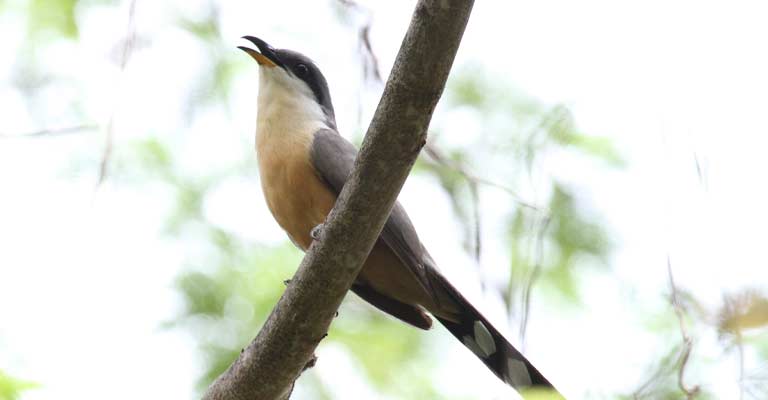
Identifying the Mangrove Cuckoo often involves listening for its vocalizations.
The bird has a unique and distinctive call that sounds like a low, guttural croak or a series of grumbling notes.
Familiarizing oneself with these vocalizations can greatly aid in its identification.
Behavioral Traits
Observing the behavior of the Mangrove Cuckoo can provide valuable clues for identification. These birds are often elusive and shy, making them challenging to spot.
They are known for their slow and deliberate movements as they forage for insects and small invertebrates among the mangrove branches.
Geographical Range
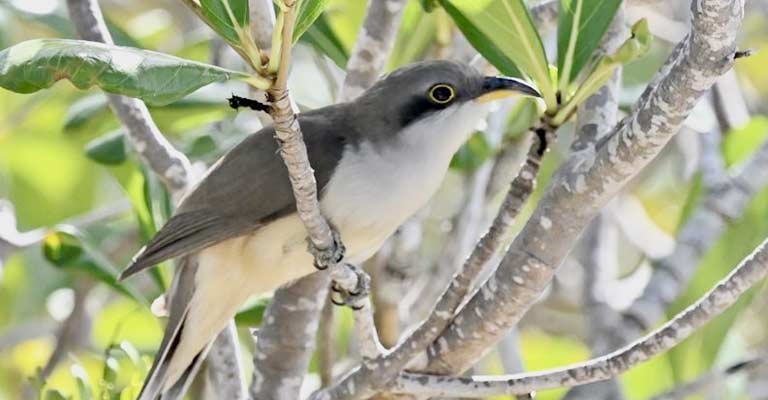
The Mangrove Cuckoo’s distribution is limited to specific regions in the Americas.
Knowing the geographical range of this species can help narrow down potential candidates when identifying cuckoos in the field.
They are typically found in coastal areas from the southern United States to northern South America.
Seasonal Migration
Understanding the seasonal movements of the Mangrove Cuckoo is essential for identification during migration periods. While some populations are resident, others may undertake seasonal migrations.
Being aware of these patterns can aid birdwatchers in identifying the Mangrove Cuckoo in different regions at various times of the year.
Identifying the Mangrove Cuckoo requires a holistic approach that considers its size, coloration, facial markings, vocalizations, habitat preferences, behavior, geographical range, and migration patterns.
By combining these key points, birdwatchers can enhance their ability to distinguish this unique species within its coastal mangrove habitat.
Mangrove Cuckoo Life History
The Mangrove Cuckoo (Coccyzus minor) is a fascinating bird species known for its elusive nature and unique adaptations to coastal mangrove environments.
Its life history encompasses a range of aspects, from its preferred habitat to nesting behaviors, breeding strategies, and conservation status.
Food
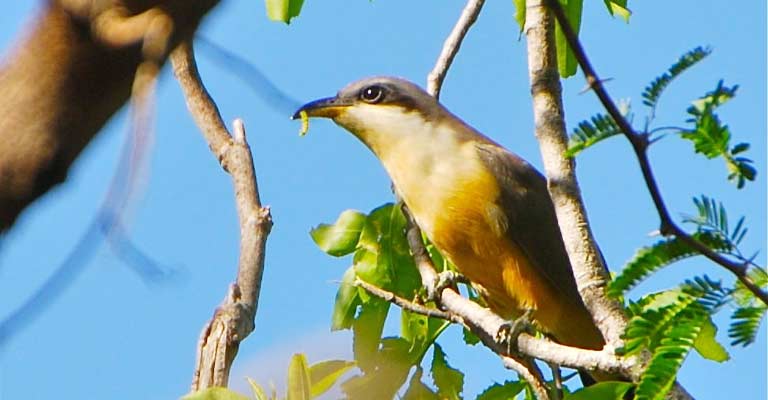
Mangrove Cuckoos are primarily insectivorous, with their diet consisting of a variety of insects, spiders, and small invertebrates.
They adeptly forage among the dense foliage of mangrove trees, using their long bills to capture prey.
Their diet may also include fruits and berries, adding a touch of versatility to their feeding habits.
Habitat
This species is intricately tied to mangrove ecosystems, thriving in the tangled and often impenetrable vegetation along coastal areas.
Mangrove Cuckoos have adapted to the challenges of this unique habitat, utilizing the complex root systems and dense canopy for shelter and foraging opportunities.
Range Map
The Mangrove Cuckoo’s distribution spans the southern United States, including Florida, along the coasts of Mexico, Central America, and northern South America.
Its range map showcases a reliance on mangrove swamps and estuarine areas, emphasizing its dependence on these coastal ecosystems.
Nesting
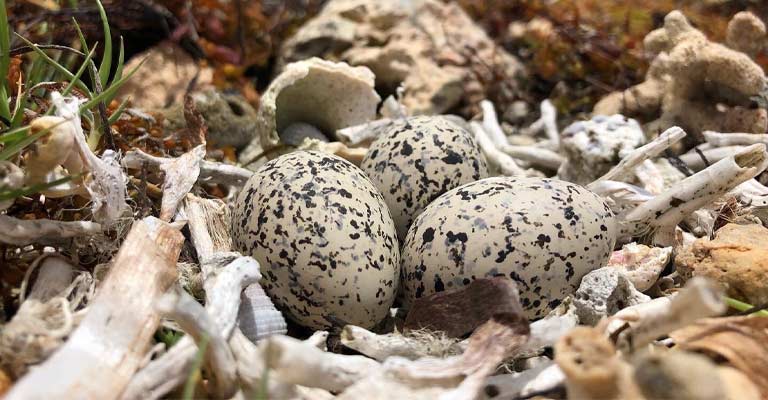
Mangrove Cuckoos are known for their secretive nesting habits. They construct flimsy, shallow cup-shaped nests made from twigs, leaves, and other plant materials.
These nests are often situated in the dense branches of mangrove trees, providing both camouflage and protection from predators.
Here’s a table summarizing nesting details of the Mangrove Cuckoo:
| Nesting Details | Mangrove Cuckoo |
| Clutch Size | 2 to 4 eggs |
| Number of Broods | Usually 1 per breeding season |
| Egg Length | Approximately 1.1 to 1.3 inches |
| Egg Width | Approximately 0.9 to 1.0 inches |
| Incubation Period | Around 13 to 15 days |
| Nestling Period | About 14 to 20 days |
| Egg Description | Pale blue-green with sparse markings |
| Nest Type | Flimsy, shallow cup made of twigs, leaves, and plant materials |
| Nest Placement | Situated in dense mangrove branches for concealment |
| Parental Involvement | Both parents share incubation and feeding responsibilities |
| Breeding Season | Typically from April to July |
| Nest Site Selection | Often in mangrove trees, utilizing the complex root systems |
| Nesting Behavior | Secretive and well-camouflaged, making observation challenging |
| Threats to Nesting Success | Predation, habitat destruction, and human disturbance |
| Conservation Importance | Preservation of mangrove habitats crucial for successful nesting |
This table provides a concise overview of key nesting characteristics for the Mangrove Cuckoo, offering insights into its reproductive biology and the factors influencing successful breeding.
Breeding
Breeding season for Mangrove Cuckoos typically occurs from April to July. The female usually lays 2 to 4 eggs, and both parents share the responsibilities of incubation and feeding the chicks.
The secretive nature of their nesting habits makes it challenging for observers to witness these stages of the breeding cycle.
Hunting Habit
Mangrove Cuckoos exhibit a distinctive hunting habit characterized by their deliberate and slow movements among the mangrove branches.
They patiently search for insects and small prey, relying on their keen eyesight and agile maneuvers to capture their quarry.
Their adeptness in navigating the intricate mangrove environment contributes to their success as hunters.
Conservation
The conservation status of Mangrove Cuckoos is of concern due to the degradation and loss of mangrove habitats.
Coastal development, pollution, and climate change pose threats to these ecosystems, affecting the availability of suitable nesting sites and food resources for the species.
Conservation efforts are essential to preserve and restore mangrove habitats, ensuring the survival of the Mangrove Cuckoo and other species dependent on these unique environments.
The life history of the Mangrove Cuckoo is intricately woven into the fabric of coastal mangrove ecosystems.
From their foraging habits and nesting behaviors to breeding strategies and conservation challenges, understanding these aspects provides a comprehensive view of the life of this remarkable bird species.
Diseases and Treatment of Mangrove Cuckoo
The Mangrove Cuckoo, like many avian species, may be susceptible to various diseases that can impact its health.
Common avian ailments such as avian pox, respiratory infections, and parasitic infestations can affect Mangrove Cuckoos.
Symptoms may include lethargy, difficulty breathing, or changes in plumage. Prompt veterinary intervention is crucial for diagnosis and treatment.
Treatment protocols often involve supportive care, including hydration, nutritional support, and medications targeting specific pathogens.
Preventive measures, such as maintaining clean habitats and regular health assessments, are essential for mitigating disease risks.
Conservation efforts to protect and restore mangrove ecosystems indirectly contribute to the overall health and resilience of Mangrove Cuckoo populations by preserving their natural habitats.
Behavioral Habits of Mangrove Cuckoo
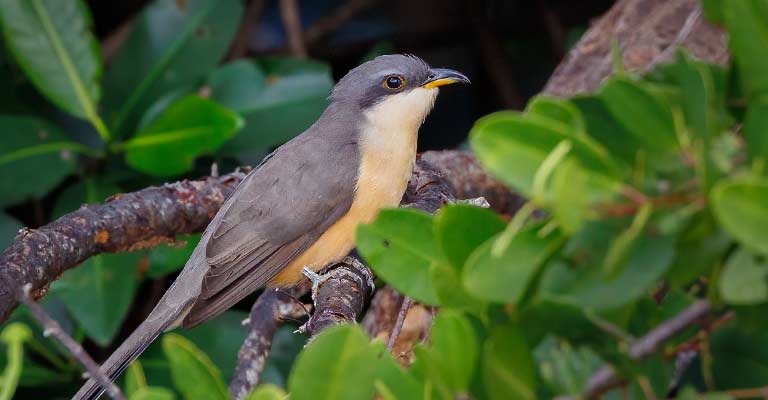
The Mangrove Cuckoo (Coccyzus minor) exhibits a fascinating array of behavioral habits, finely tuned to its coastal mangrove habitat.
These behavioral traits, shaped by evolutionary adaptations, contribute to the bird’s survival in the intricate and challenging ecosystems it calls home.
Foraging Behavior
Mangrove Cuckoos are primarily insectivores, relying on a diverse diet of insects, spiders, and small invertebrates.
Their foraging behavior is characterized by deliberate and slow movements through the dense mangrove branches.
With their long bills, they skillfully navigate the tangled vegetation, capturing prey with precision.
Occasionally, they may supplement their diet with fruits and berries, showcasing a degree of dietary flexibility.
Social Interactions
Mangrove Cuckoos are generally solitary birds, and interactions between individuals are often limited to the breeding season when pairs form for nesting.
During this period, pairs share responsibilities such as incubation and feeding, showcasing cooperative behaviors that contribute to the success of their offspring.
Communication
The vocalizations of the Mangrove Cuckoo play a significant role in communication. Their calls are distinctive, resembling low, guttural croaks or grumbling notes.
These vocalizations serve various purposes, including mate attraction, territory establishment, and communication between breeding pairs.
The secretive nature of their habitat means that these calls are essential for maintaining contact with conspecifics.
Mating and Nesting
Mangrove Cuckoos engage in secretive nesting behaviors, constructing flimsy cup-shaped nests in the dense canopy of mangrove trees.
Breeding pairs share responsibilities during the breeding season, with both parents participating in incubation and the care of nestlings.
Their nests are well-camouflaged, protecting potential predators.
Territoriality
Territorial behavior is evident in Mangrove Cuckoos, particularly during the breeding season. They defend their nesting territories from intruders, employing vocalizations and displays to communicate boundaries.
The secretive nature of their habitat enhances the importance of maintaining exclusive territories for successful breeding.
The behavioral habits of the Mangrove Cuckoo reflect a finely tuned adaptation to its coastal mangrove environment.
From foraging and social interactions to communication and nesting behaviors, these habits contribute to the species’ resilience in the challenging ecosystems it inhabits.
Understanding these behavioral traits provides a deeper appreciation for the intricate lives of these elusive birds.
Wrapping Up
The Mangrove Cuckoo, with its unique nesting habits, foraging behaviors, and adaptations to coastal environments, stands as a captivating symbol of avian resilience.
Its secretive nature, cooperative breeding strategies, and reliance on mangrove ecosystems underscore the delicate balance these birds maintain for their survival.
As we delve into their behavioral intricacies and ecological dependencies, it becomes clear that the conservation of mangrove habitats is not just crucial for the Mangrove Cuckoo but for the broader health of coastal ecosystems. Thank you very much.